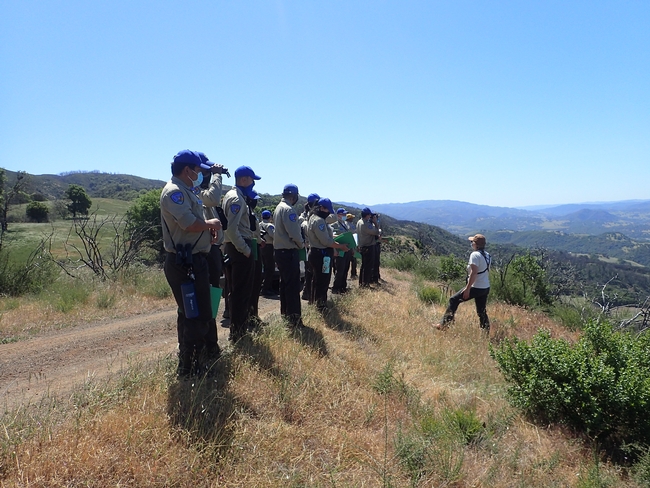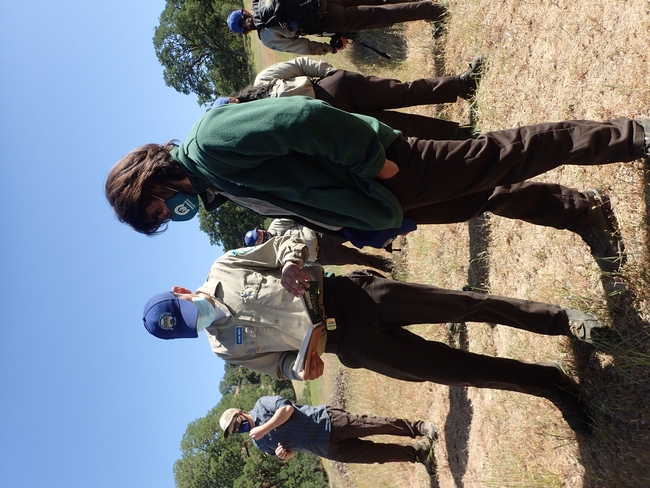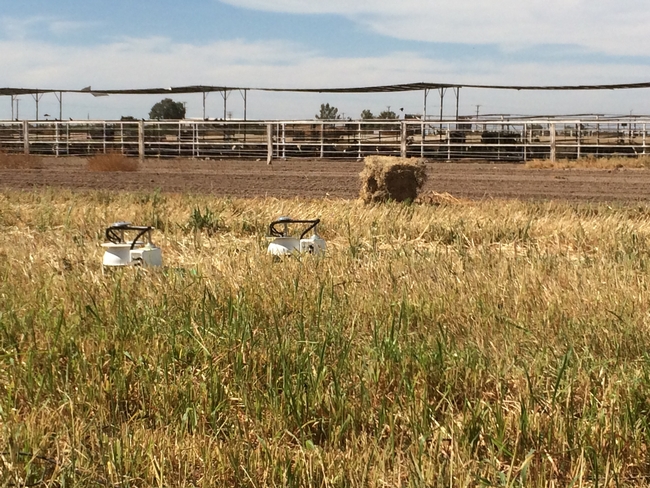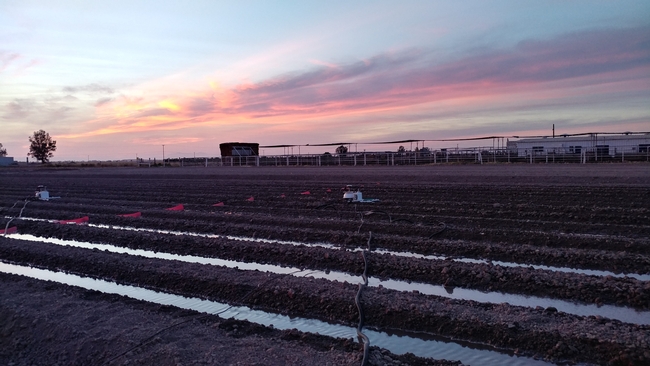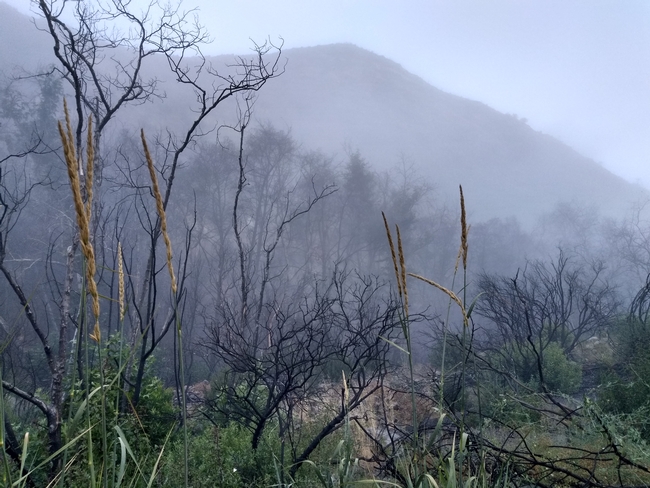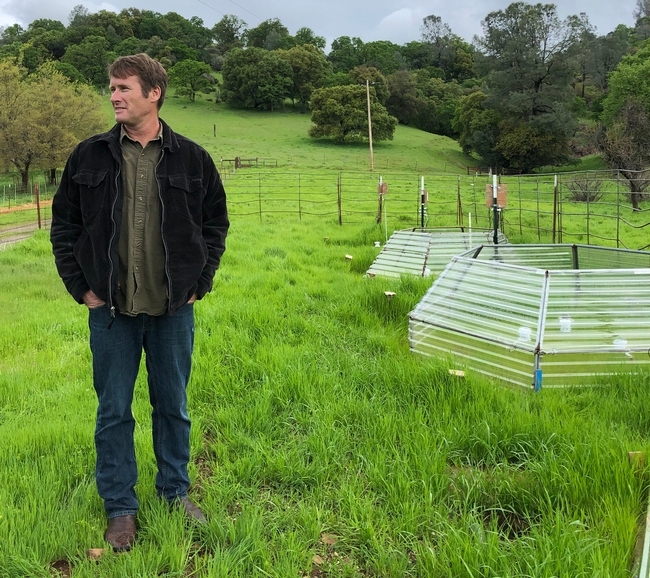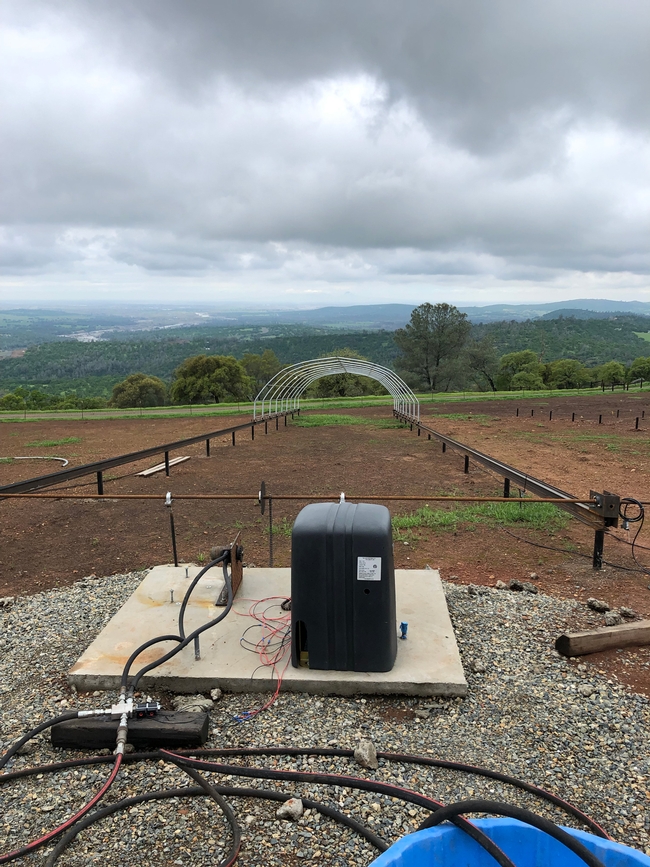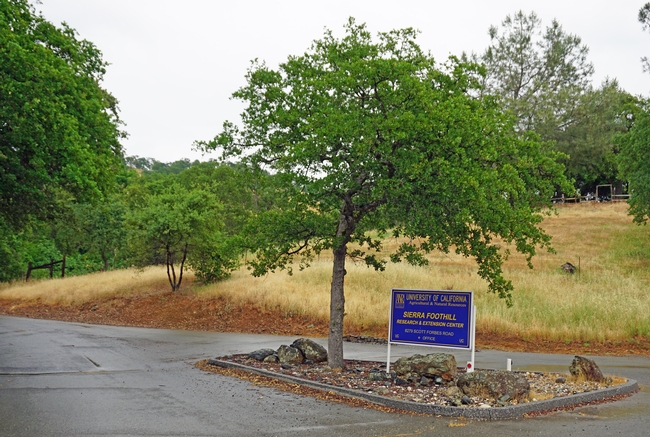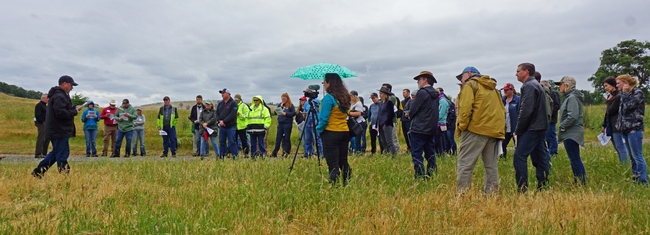Posts Tagged: Research and Extension Center
New wave of California Naturalists emerge from course at Hopland REC
Thirty-eight young, budding naturalists sit in a meadow while journaling and sketching their observations of the wildflowers and birds around them. They have come from various educational backgrounds to gather at the University of California Agriculture and Natural Resources' Hopland Research and Extension Center (REC) to learn about local natural ecosystems through a California Naturalist course.
Although they vary in expertise, these students share a common motivation: immerse themselves in the natural world and eventually teach others about its importance.
“The class really changed the way I view the world around me,” said Will Zuniga, a recent class participant at Hopland REC. “Now that I've taken it, I don't just see plants around me – I see stories. I understand more about the relationship that all of nature's moving parts have with each other. The class has given me more drive to learn about the world around me and to teach others as well.”
Under the UC ANR umbrella, the California Naturalist Program certifies participants through an immersive 40+ hour class delivered by one of its partner organizations, in this case, the California Conservation Corps (CCC). Aged 18 to 25 (and U.S. military veterans up to age 29) and from diverse educational backgrounds across the state, these California Naturalist students worked hard to fulfill the mission of the CCC – to protect and enhance California's natural resources and communities through education and service.
The California Naturalist Program promotes environmental literacy and stewardship through discovery and action. The program is designed to introduce Californians to the wonders of our unique ecology, engage the public in the study and stewardship of California's natural communities, and increase community and ecosystem resilience. Many other states have similar naturalist programs, but this is the first statewide program in California.
“California Naturalist training allows people of different backgrounds to come together to set what is the standard for how we talk about the sky, the ground below us, and the water that's flowing around us,” reflected Jacob Croasdale, a former class participant. “[They teach us] how to engage respectfully in a way that allows us to both receive and give back to nature.”
Although students graduate with broad knowledge of California's natural wonders, prior knowledge of the course's subject matter is unnecessary. “At first, I thought…I don't belong here. I'm just this artist - what do I have to offer?” shared Monique Wales, another former class participant. “There were Master Gardeners, geologists, biologists and people with crazy amounts of knowledge. But we all came together with such enthusiasm, and we wanted to learn from each other. It was such a fun group.”
“People who are thinking about the California Naturalist program but aren't sure that they know enough to step into something where the language is maybe more technical than they're familiar with should not be intimidated,” added Pete Devine, resident naturalist at Yosemite Conservancy. “A lot of participants are beginners and just generally interested folks. These people belong in the California Naturalist Program.”
A quick peek at the syllabus reveals many themes, field trips and interactions with local experts that culminate in the well-rounded knowledge necessary to help preserve our unique ecosystems. California has an incredibly diverse range of wildlife, habitats, rivers, lakes and coastal resources – wild and urban alike – and ecosystem and community resilience are essential.
After the course is completed, California Naturalists perform service through education and interpretation, stewardship, participatory science, environmental program support, community resilience and environmental justice. To date, certified California Naturalists, together with Climate Stewards (another component of the program), have volunteered more than 250,000 hours, worth over $7 million, in 52 of 58 counties in California.
The relationship between CCC and California Naturalist was piloted at the Hopland REC over the last two years and is now being rolled out across the state with support from the Prop 64 Youth Community Access fund. Overall, the project aims to offer three California Naturalist instructor trainings for 48 youth leaders, 24 California Naturalist certification courses for 480 Corps members, visits to or engagement with over 40 unique cultural and natural resources around the state each year, and 3,840 hours of service-learning outreach through youth-led video capstone projects promoting natural and cultural resources.
Overall (and most importantly), the California Naturalist Program allows corps members to have a solid connection to the “why” of their hard work.
Perhaps if we can all connect a bit more with nature in our backyard, we too will see the stories hidden in the plants, water, animals and land.
Drip irrigation in arid regions can cut greenhouse gas emissions, improve air quality
Study at Desert Research and Extension Center highlights agriculture's sustainability role
Under the blistering sun of Southern California's Imperial Valley, it's not surprising that subsurface drip irrigation is more effective and efficient than furrow (or flood) irrigation, a practice in which up to 50% of water is lost to evaporation.
But a recent study also concludes that drip irrigation can dramatically reduce greenhouse gas emissions from soil – which contribute to climate change and unhealthy air quality in the region – without sacrificing yields of forage crops alfalfa and sudangrass.
“It was really exciting to see,” said lead author Holly Andrews, a National Science Foundation postdoctoral fellow at the University of Arizona. “The crop yield was at least maintained and in some cases increased, but the water use and gaseous emissions were especially decreased under drip irrigation.”
Desert REC crucial to collecting data
Andrews and her colleagues gathered data from field studies at University of California Agriculture and Natural Resources' Desert Research and Extension Center, a crucial hub of desert agriculture research for more than 100 years. Studies in that context are increasingly important, as much of California and the Southwest becomes hotter and drier.
“We already have this history of looking at drip irrigation at this site, so our study was trying to build on that,” said Andrews, who lauded Desert REC's facilities and staff.
In their study published in Agriculture, Ecosystems & Environment, researchers found that – in comparison to furrow irrigation – drip irrigation in alfalfa slashed per-yield soil carbon dioxide emissions by 59%, nitrous oxide by 38% and nitric oxide by 20%.
Nitrous oxide is a greenhouse gas with nearly 300 times more warming potential as carbon dioxide, and nitric oxide is a precursor to ozone and major contributor to air pollution.
While drip irrigation only decreased water demand 1% in alfalfa, the practice led to a substantial 49% decrease in irrigation for sudangrass. For more fertilizer-intensive sudangrass, drip irrigation also reduced soil emissions of nitrous oxide by 59% and nitric oxide by 49% – the result of drip irrigation making those fertilizers more efficient.
Water management can help mitigate climate change
Studying alfalfa and sudangrass – forage crops with very different fertilizer requirements – was a strategic choice by the researchers. They are number one and number three on the list of most widely grown crops by acreage in the Imperial Valley (Bermudagrass, another forage crop, is number two).
With so much land dedicated to producing these crops, the adoption of drip irrigation at scale could deliver significant benefits to residents' health and quality of life.
“The thought that saving water can increase yields while lowering the emission of trace gases that affect regional air quality and Earth's climate is quite encouraging,” said Pete Homyak, an assistant professor of environmental sciences at UC Riverside who contributed to the study. “This is especially true for the Imperial Valley, an arid region where water is a limited resource and where residents are exposed to bad air quality.”
Homyak, who is affiliated with UC ANR through UC Riverside's Agricultural Experiment Station, said that this study illustrates how changes in water management can substantially mitigate agricultural impacts on the environment.
The study findings should encourage growers to replace furrow irrigation systems with drip irrigation infrastructure – especially in combination with financial incentives from the state, such as cap-and-trade and carbon credit programs, that can help defray high installation costs.
“It really is worthwhile if you're thinking sustainability and environmental activism in how agriculture can actually support climate change mitigation,” Andrews explained. “These practices might be a way that we can start to change that picture a little bit – and make agriculture more sustainable by tailoring irrigation management to local climate conditions.”
In addition to Andrews and Homyak, the other study authors are Patty Oikawa, California State University, East Bay; Jun Wang, University of Iowa; and Darrel Jenerette, UC Riverside.
How will climate change affect Southern California?
UC Thelma Hansen Fund to host climate webinar series, April 27-29
Members of the public are invited to attend a free webinar series discussing the effects of climate change on Southern California. At the three-day webinar Climate Change: What Does It Mean for Southern California?, UCLA climate scientist Daniel Swain and UC Agriculture and Natural Resources scientists will discuss climate changes anticipated, impacts on agriculture, wildfire risk and how to prepare for it, and ways to communicate about climate and to build resilience in communities.
“We are hearing a lot about climate change, but it can be difficult for the average person to figure out what it means for where they live and to understand the science behind it,” said Annemiek Schilder, director of UC Cooperative Extension in Ventura County and UC ANR Hansen Agricultural Research and Extension Center.
Topics of discussion include drought, adaptation for agriculture, fire management on rangelands and wildland-urban interface areas, and how UC Climate Stewards might improve climate understanding and empower community-level stewardship.
“All of us need to be better informed about this new reality and know how to respond to it,” said Schilder, who is organizing the event. “For Southern California, as a region with intense agricultural production and huge urban populations living in proximity to the coast, climate change could have devastating impacts. One of my favorite Latin sayings applies: Serius est quam cogitas – it is later than you think!”
Although residents may be concerned about climate change, they may not know what to do. The scientists will offer suggestions.
“People may feel powerless in the face of something that is happening on a global scale, but there are indeed things that can be done by individuals to mitigate the effects and to build resilience in the face of small and large disasters,” Schilder said. “In fact, doing nothing has a huge cost associated with it. Think of the economic damage already incurred by climatic extremes in recent years and the costs associated with possible future waves of climate refugees coming to the U.S.”
Registration for the webinar series, which is sponsored by the UC Thelma Hansen Fund, is free. To register and see the agenda and speaker biographies, visit http://ucanr.edu/hansensocalclimate.
Speakers include
- Daniel Swain, Ph.D., climate scientist, UCLA Institute of the Environment and Sustainability – Climate Change in California: A Drier or Wetter Future—or…Both?
- Sarah-Mae Nelson, M.S., UC Climate Stewards academic coordinator – UC Climate Stewards: Fostering Resilience in California Communities and Ecosystems
- Tapan Pathak, Ph.D., UC Cooperative Extension specialist in climate adaptation in agriculture, UC Merced – Climate Change Trends and Impacts on Agriculture in California and Ventura
- Ben Faber, Ph.D., UCCE soils, water and subtropical crops advisor, Ventura County – Heat, Wind, Freeze, Wind, Repeat
- Nicki Anderson, UCCE community education specialist, Ventura County – Overview of the Healthy Soils Program
- Max Moritz, Ph.D., UCCE wildfire specialist, Bren School of Environmental Science & Management, UC Santa Barbara – How Can We Address the Growing Wildland-Urban Interface Problem in California?
- Matthew Shapero, M.A.,UCCE livestock and range advisor, Ventura and Santa Barbara counties – Fire and Rangelands: Impacts on Ventura County Livestock Agriculture Counties
- Sabrina Drill, Ph.D., UCCE natural resources advisor, Ventura and Los Angeles counties – SAFER, Sustainable and Fire-Resistant Homes & Landscapes
If you missed the "Climate Change: What does it Mean for Southern California" webinars, watch the recordings:
April 27 https://youtu.be/8zfn3aaUAv0
April 28 https://youtu.be/dKlKk8sqoaE
April 29 https://youtu.be/2oh82L_wnTw
UC research could help farmers face droughts worldwide
Sorghum is not only a potential drought-tolerant crop for the San Joaquin Valley, it also presents the opportunity for scientists to understand the mechanism behind drought tolerance at the genetic level, said UCCE sorghum specialist Jeff Dahlberg in a segment on ABC 30 Action News.
Reporter Cristina Davies spent an hour and a half at the UC Kearney Agricultural Research and Extension Center in Parlier during the sorghum harvest to learn about the potential of sorghum research.
"If we can elucidate the genetics behind (drought tolerance), what we believe is we can use those genetics to see if the genetics are available in corn, or in rice, or in wheat," Dahlberg said. "I think the genes may be there. We just don't have the tools yet to search for the genes in those crops."
Conducting drought-tolerance research in California is ideal because the summer is typically devoid of rain. Researchers can control exactly how much water is applied to each sorghum plot. The research has revealed more than 100 genetic markers that may confer drought tolerance.
"We've been really thrilled with the data that's been coming out of this. Like most research, we are learning so many things we don't understand," Dahlberg said.
The research is being conducted in collaboration with the USDA's Agricultural Research Service research center, which is across the street from Kearney. USDA research scientist Devin Coleman-Derr was present for the sorghum harvest.
"Like humans take probiotics, there may be a use for microbes in sort of promoting better and better yields in the field," Coleman-Derr said.
The 330-acre UC Kearney Agricultural Research and Extension Center is the University of California's largest off-campus agricultural research facility.
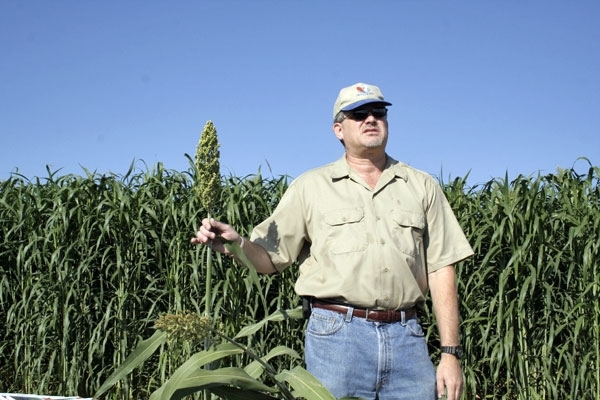
UCCE specialist Jeff Dahlberg studies sorghum at the UC Kearney Agricultural Research and Extension Center in Parlier.
UC ANR research to determine future climate change impacts today
Scientific evidence of a warming climate in California and across the globe is clear, but the impacts on ecosystems and agriculture are still difficult to predict.
Sophisticated computer models are used to forecast future climate. Understanding that temperature and precipitation levels will change in the future does not tell the full story: UC Agriculture and Natural Resources researchers also want real-world experience under those future conditions.
Moreover, some agricultural operations have higher sensitivity to the changes than others. Rangeland forage is particularly sensitive to climate changes since, unlike irrigated agriculture, ranchers rely solely on precipitation. They have no control over how much and when it rains.
“It's tricky business,” said rangeland expert Jeremy James, the director of the UC Sierra Foothill Research and Extension Center in Browns Valley. “It's not easy to forecast. We have to address the uncertainty in a realistic manner.”
Discovering climate change impact on rangeland
In order to study different climate projections on rangeland, James and Maggi Kelly, director of the UC ANR Informatics and Global Information Systems special program, have begun development of a research site that will allow scientists to manipulate the temperature and rainfall on sections of rangeland to understand what would happen under predicted weather scenarios.
With a $220,000 National Science Foundation grant, construction is now underway on a four-acre site at the research center that will help scientists learn how temperature and precipitation will impact growth and diversity of forage that ranchers use to raise their livestock.
“We need to know how rangelands will respond when conditions change,” James said. “Will we grow more, but dry out earlier? Will we have more medusahead (an undesirable rangeland weed) or more soft chess (a high quality forage)?”
When complete, 16 shelters on steel tracks will be connected to computer systems and hydraulic motors to move them up or down a research plot. The shelters and other equipment will allow scientists to precisely control the amount of precipitation (or irrigation water) that rains onto the plot. Other systems will give researchers control of air temperature.
“This facility isn't designed for one type of research,” James said. “It is designed to conduct a wide variety of research by scientists over the next several decades. With this setup, we can look at the effect of climate change on soil biological communities, soil carbon, insect communities, plant-insect interactions and oak seedling recruitment.”
The research results from the project should provide ranchers and land managers a better understanding of how climate change may impact agriculture and ecosystem function on rangeland while also providing important information on how to minimize impacts of these changes.
Some aspects of the research facility's development are not covered with funding from the National Science Foundation. The scientists are looking for additional support to complete the project.
For more information, contact James at jjjames@ucanr.edu.
Current work underway at the Sierra Foothill Research and Extension Center
The Sierra Foothill REC, a 5,000-acre facility on the Yuba River, has supported research, education and outreach in the Sierra foothills since 1960. Multiple lines of research are being conducted at SFREC. During a recent workshop, scientists from UC Davis, UC Berkeley and UC Cooperative Extension shared a sampling of their work at SFREC.
UCCE livestock and natural resources advisor Dan Macon described a project aimed at helping ranchers make decisions about maintaining a cattle herd when faced with impending drought. Ranchers are reluctant to sell off their cattle even when the near future weather forecast is dire.
“Science tells us you shouldn't feed your way out of a drought,” Macon said. “But you want everything to stay the same. You want to maintain your genetic potential and keep cows that are familiar with the area.”
Working with ranchers, the research project will compare management practices to determine the best way forward when the future looks meteorologically bleak.
“We're assigning cows to a traditional weaning and early weaning groups,” Macon said. “They'll be out on the range from March to early September under different parameters. We're also tying in economics, the value of genetic potential and the value of having cows who know the landscape.”
Research by University of Oregon post doctorate researcher Ashley Shaw is looking into whether compost applied to rangeland will help mitigate climate change by sequestering more carbon, and also benefit forage under drought by increasing the soil's water-holding capacity and improving nutrient delivery.
Preliminary results are promising. A single application of 1/4-inch of compost resulted in forage production that was higher than areas where no amendment was applied and areas that were treated with a chemical fertilizer.
“The biggest impact was under drought shelters,” said Shaw, referring to PVC frames that were covered with plastic during rain events to understand the impact of the treatment under dry conditions. “In the drought plots, the areas where compost was applied are staying green longer.”
A defining research tool at SFREC is a dataset that includes information on monthly rainfall and forage production going back 40 years.
A review of the data shows surprising variations and correlations at the center, where forage production averages 3,000 pounds per acre, but ranges from about 1,000 pounds per acre in 1987, to over 5,000 pounds per acre in 2018, when there was so much growth, “we didn't have enough animals to graze,” James said.
The dataset paints a spectrum of the variation that ranchers across the state must navigate to manage their livestock and rangeland in a way that is profitable and ecologically sound. Research at the Sierra Foothill REC offers invaluable information to help them better understand the ecosystem and make informed decisions.


